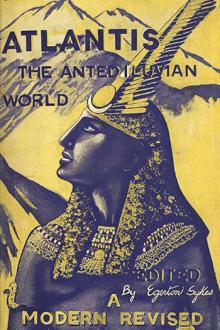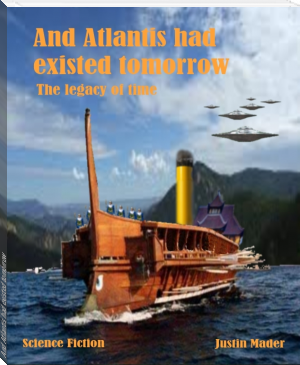Atlantis: The Antedeluvian World by Ignatius Donnelly (thriller novels to read .TXT) 📕

- Author: Ignatius Donnelly
- Performer: -
Book online «Atlantis: The Antedeluvian World by Ignatius Donnelly (thriller novels to read .TXT) 📕». Author Ignatius Donnelly
In the alphabetical table which we herewith append we have represented the sign V, or vau, or f, by the Maya sign for U. “In the present so-called Hebrew, as in the Syriac, Sabæic, Palmyrenic, and some other kindred writings, the vau takes the place of F, and indicates the sounds of v and u. F occurs in the same place also on the Idalian tablet of Cyprus, in Lycian, also in Tuarik (Berber), and some other writings.”
(“American Cyclopædia,” art. F.)
Since writing the above, I find in the “Proceedings of the American Philosophical Society” for December, 1880, p. 154, an interesting article pointing out other resemblances between the Maya alphabet and the Egyptian. I quote:
It is astonishing to notice that while Landa’s first B is, according to Valentini, represented by a footprint, and that path and footprint are pronounced Be in the Maya dictionary, the Egyptian sign for B was the human leg.
“Still more surprising is it that the H of Landa’s alphabet is a tie of cord, while the Egyptian H is a twisted cord. . . . But the most striking coincidence of all occurs in the coiled or curled line representing Landa’s U; for it is absolutely identical with the Egyptian curled U. The Mayan word for to wind or bend is Uuc; but why should Egyptians, confined as they were to the valley of the Nile, and abhorring as they did the sea and sailors, write their U precisely like Landa’s alphabet U in Central America? There is one other remarkable coincidence between Landa’s and the Egyptian alphabets; and, by-the-way, the English and other Teutonic dialects have a curious share in it.
Landa’s D (T) is a disk with lines inside the four quarters, the allowed Mexican symbol for a day or sun. So far as sound is concerned, the English day represents it; so far as the form is concerned, the Egyptian ‘cake,’ ideograph for (1) country and (2) the sun’s orbit is essentially the same.”
It would appear as if both the Phœnicians and Egyptians drew their alphabet from a common source, of which the Maya is a survival, but did not borrow from one another. They followed out different characteristics in the same original hieroglyph, as, for instance, in the letter b. And yet I have shown that the closest resemblances exist between the Maya alphabet and the Egyptian signs—in the c, h, t, i, k, m, n, o, q, and s—eleven letters in all; in some cases, as in the n and k, the signs are identical; the k, in both alphabets, is not only a serpent, but a serpent with a protuberance or convolution in the middle! If we add to the above the b and u, referred to in the “Proceedings of the American Philosophical Society,” we have thirteen letters out of sixteen in the Maya and Egyptian related to each other. Can any theory of accidental coincidences account for all this? And it must be remembered that these resemblances are found between the only two phonetic systems of alphabet in the world.
Let us suppose that two men agree that each shall construct apart from the other a phonetic alphabet of sixteen letters; that they shall employ only simple forms—combinations of straight or curved lines—and that their signs shall not in anywise resemble the letters now in use. They go to work apart; they have a multitudinous array of forms to draw from the thousand possible combinations of lines, angles, circles, and curves; when they have finished, they bring their alphabets together for comparison. Under such circumstances it is possible that out of the sixteen signs one sign might appear in both alphabets; there is one chance in one hundred that such might be the case; but there is not one chance in five hundred that this sign should in both cases represent the same sound. It is barely possible that two men working thus apart should bit upon two or three identical forms, but altogether impossible that these forms should have the same significance; and by no stretch of the imagination can it be supposed that in these alphabets so created, without correspondence, thirteen out of sixteen signs should be the same in form and the same in meaning.
It is probable that a full study of the Central American monuments may throw stronger light upon the connection between the Maya and the European alphabets, and that further discoveries of inscriptions in Europe may approximate the alphabets of the New and Old World still more closely by supplying intermediate forms.
We find in the American hieroglyphs peculiar signs which take the place of pictures, and which probably, like the hieratic symbols mingled with the hieroglyphics of Egypt, represent alphabetical sounds. For instance, we find this sign on the walls of the palace of Palenque, ### ; this is not unlike the form of the Phœnician t used in writing, ### and ### ; we find also upon these monuments the letter o represented by a small circle, and entering into many of the hieroglyphs; we also find the tau sign (thus ### ) often repeated; also the sign which we have supposed to represent b, ### ; also this sign, ### , which we think is the simplification of the letter k; also this sign, which we suppose to represent e, ### ; also this figure, ### ; and this ### . There is an evident tendency to reduce the complex figures to simple signs whenever the writers proceed to form words.
Although it has so far been found difficult, if not impossible, to translate the compound words formed from the Maya alphabet, yet we can go far enough to see that they used the system of simpler sounds for the whole hieroglyph to which we have referred.
Bishop Landa gives us, in addition to the alphabet, the signs which represent the days and months, and which are evidently compounds of the Maya letters. For instance, we have this figure as the representative of the month Mol ### . Here we see very plainly the letter ### for m, the sign ### for o; and we will possibly find the sign for l in the right angle to the right of the m sign, and which is derived from the figure in the second sign for l in the Maya alphabet.
One of the most ancient races of Central America is the Chiapenec, a branch of the Mayas. They claim to be the first settlers of the country.
They came, their legends tell us, from the East, from beyond the sea.
And even after the lapse of so many thousand years most remarkable resemblances have been found to exist between the Chiapenec language and the Hebrew, the living representative of the Phœnician tongue.
The Mexican scholar, Señor Melgar (“North Americans of Antiquity,” p.
475) gives the following list of words taken from the Chiapenec and the Hebrew:
------------+-----------+ | English. | Chiapenec. | Hebrew. | ------------+-----------+ | Son | Been | Ben. | ------------+-----------+ | Daughter | Batz | Bath. | ------------+-----------+ | Father | Abagh | Abba. | ------------+-----------+ | Star in Zodiac | Chimax | Chimah. | ------------+-----------+ | King | Molo | Maloc. | ------------+-----------+ | Name applied to Adam | Abagh | Abah. | ------------+-----------+ | Afflicted | Chanam | Chanan. | ------------+-----------+ | God | Elab | Elab. | ------------+-----------+ | September | Tsiquin | Tischiri. | ------------+-----------+ | More | Chic | Chi. | ------------+-----------+ | Rich | Chabin | Chabic. | ------------+-----------+ | Son of Seth | Enot | Enos. | ------------+-----------+ | To give | Votan | Votan. | ------------+-----------+Thus, while we find such extraordinary resemblances between the Maya alphabet and the Phœnician alphabet, we find equally surprising coincidences between the Chiapenec tongue, a branch of the Mayas, and the Hebrew, a branch of the Phœnician.
Attempts have been repeatedly made by European scholars to trace the letters





Comments (0)